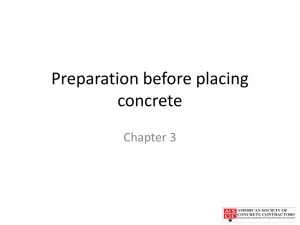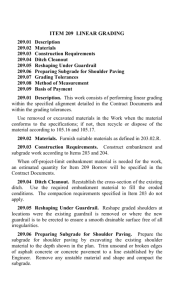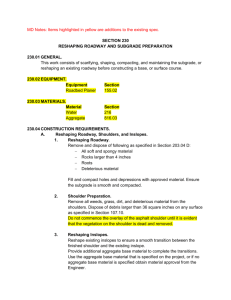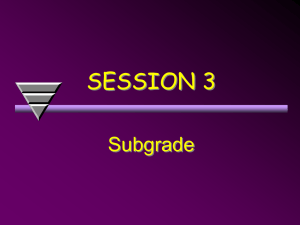204_10162009
advertisement
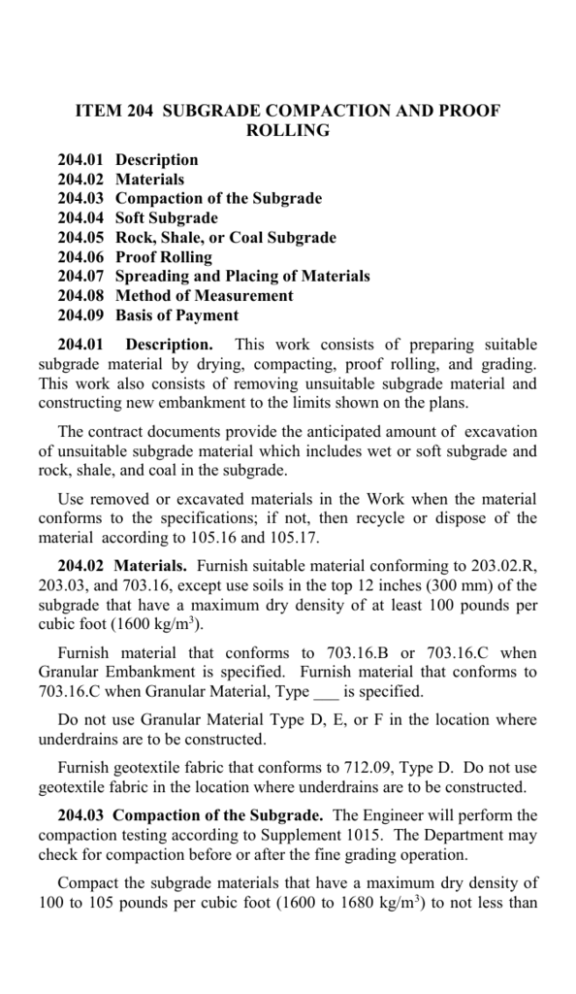
ITEM 204 SUBGRADE COMPACTION AND PROOF ROLLING 204.01 204.02 204.03 204.04 204.05 204.06 204.07 204.08 204.09 Description Materials Compaction of the Subgrade Soft Subgrade Rock, Shale, or Coal Subgrade Proof Rolling Spreading and Placing of Materials Method of Measurement Basis of Payment 204.01 Description. This work consists of preparing suitable subgrade material by drying, compacting, proof rolling, and grading. This work also consists of removing unsuitable subgrade material and constructing new embankment to the limits shown on the plans. The contract documents provide the anticipated amount of excavation of unsuitable subgrade material which includes wet or soft subgrade and rock, shale, and coal in the subgrade. Use removed or excavated materials in the Work when the material conforms to the specifications; if not, then recycle or dispose of the material according to 105.16 and 105.17. 204.02 Materials. Furnish suitable material conforming to 203.02.R, 203.03, and 703.16, except use soils in the top 12 inches (300 mm) of the subgrade that have a maximum dry density of at least 100 pounds per cubic foot (1600 kg/m3). Furnish material that conforms to 703.16.B or 703.16.C when Granular Embankment is specified. Furnish material that conforms to 703.16.C when Granular Material, Type ___ is specified. Do not use Granular Material Type D, E, or F in the location where underdrains are to be constructed. Furnish geotextile fabric that conforms to 712.09, Type D. Do not use geotextile fabric in the location where underdrains are to be constructed. 204.03 Compaction of the Subgrade. The Engineer will perform the compaction testing according to Supplement 1015. The Department may check for compaction before or after the fine grading operation. Compact the subgrade materials that have a maximum dry density of 100 to 105 pounds per cubic foot (1600 to 1680 kg/m 3) to not less than 102 percent of maximum dry density. Compact all other subgrade materials to not less than 100 percent of maximum dry density. The Engineer will determine the maximum dry density using AASHTO T 99, AASHTO T 272, or test section method in Supplement 1015. If needed for compaction acceptance, use the test section method as follows: A. Use a minimum of eight passes with a steel wheel roller having a minimum weight or centrifugal force of 10 tons (9 metric tons). B. The Engineer will use at least 98 percent of the test section maximum dry density for acceptance of the production subgrade compaction. C. Use at least the same number of passes and compactive effort used to construct the test section for the production subgrade compaction. D. Construct a new test section when the subgrade material, supporting foundation or embankment material changes. E. Reduce the moisture content if the material becomes unstable. The Engineer may reduce the minimum number of passes if the passes are detrimental to compaction. Use the moisture controls specified in 203.07.A. Compact the subgrade under pavements to a depth of 12 inches (300 mm) below the subgrade surface and 18 inches (450 mm) beyond the edge of the surface of the pavement, paved shoulders, or paved medians. Compact all subgrades under paved driveways, paved mailbox turnouts, curbs and gutters to a depth of 12 inches (300 mm) below the subgrade surface. Maintain and drain the subgrade according to 203.04.A. 204.04 Soft Subgrade. If satisfactory subgrade stability cannot be obtained by moisture control and compaction according to 204.03, the Engineer will direct the Contractor to remove the soft material and to construct the replacement material to the finished grade within the tolerances specified in 203.08. Conduct the removal and replacement operations to allow the Engineer to measure the cross-sections before placing the replacement material. Remove the soft subgrade material to the depth determined by the Engineer or specified in the Contract Documents. Replace with suitable material according to 204.07. 204.05 Rock, Shale, or Coal Subgrade. If an aggregate base is not a part of the pavement design, undercut the subgrade 2 feet (0.6 m) below the final subgrade elevation where rock, shale, or coal is encountered. If an aggregate base is part of the pavement design, reduce the above 2-foot (0.6 m) undercut by the thickness of the aggregate base or bases. Maintain a total undercut depth of 2 feet (0.6 m) below the bottom of the asphalt or concrete pavement. Excavate for a width of 1 foot (0.3 m) beyond the shoulders. Replace with suitable material according to 204.07. 204.06 Proof Rolling. Perform the testing of the stability and uniformity of the subgrade compaction in locations shown on the plans by proof rolling. Use a proof roller conforming to the following: A. Four heavy pneumatic tire wheels mounted on a rigid steel frame. B. Wheels evenly spaced in one line across the width of the roller. C. Wheels arranged so that all wheels carry approximately equal loads when operated over an uneven surface. D. A maximum center-to-center spacing between adjacent wheels not exceeding 32 inches (0.8 m). E. A body for ballast loading capable of varying the gross load from 25 to 50 tons (23 to 45 metric tons). F. Tires capable of operating at inflation pressures ranging from 90 to 150 pounds per square inch (620 to 1040 kPa). Provide a tire pressure gage for measurement before use. G. Tires filled with liquid from 90 to 95 percent by volume. Provide ballast that consist of ingots of known weight, sand bags with a weight of 100 pounds (45 kg), bags of other material of known weight, or other suitable material such that the total ballast weight is readily determinable at all times. Provide sufficient ballast to load equipment to a maximum gross weight of 50 tons (45 metric tons). Furnish the Engineer information verifying that the weights and tire pressures can be met. After compacting the subgrade according to 204.03 and before placing overlying course, proof roll designated subgrade areas. If proof rolling is performed after the underdrains are installed, do not use the proof roller within 1 1/2 feet (450 mm) of the underdrains. Ensure that the subgrade moisture content at the time of proof rolling is within 2 percent of the moisture used for acceptance in 204.03. Adjust the load and tire inflation pressure according to the following: A. For soils classified as A-3, A-4, A-6, or A-7-6, use a 35-ton (32 metric tons) roller with a tire pressure of 120 pounds per square inch (820 kPa). B. For granular soils, and soil, rock, and granular mixtures, use a 50ton (46 metric tons) roller with a tire pressure of 150 pounds per square inch (1030 kPa). C. Measure the tire pressure in the presence of the Engineer. Operate equipment at a speed between 2 1/2 and 5 miles per hour (4 and 8 km/hr). Adjust the speed to allow the Engineer to measure the deflections, ruts, or elasticity. Make only one trip of the proof roller over any area. Offset trips to completely cover the subgrade area. Where proof rolling indicates areas of soft subgrade or areas of nonuniform subgrade stability, the Engineer will investigate for the source of the problem. The Engineer will check the subgrade materials, density, and moisture content according to 204.02 and 204.03. The Contractor is responsible for all problems found in the materials constructed under the Contract Documents. Correct all deficiencies found. Correct the subgrade to a uniform and satisfactory stability as directed by the Engineer. After proof rolling, check the subgrade for conformance to the plans, and correct all surface irregularities. Shape the subgrade within the tolerances specified in 203.08. 204.07 Spreading and Placing of Materials. Place materials, conforming to 204.02, in 8-inch (200 mm) loose lifts. The Engineer may increase the lift thickness depending on the stability of the bottom of the cut. The Engineer may increase the lift thickness up to 24 inches (600 mm) to obtain stability at the top of the lift. Doze, track, or manipulate the material to maximize the density and stability. Once stability is achieved, compact according to 204.03. When specified, place the geotextile fabric at the bottom of the cut or at locations designated in the Contract Documents. Place the geotextile fabric smooth and free of tension or wrinkles. Fold or cut the geotextile fabric to conform to curves. Overlap a minimum of 18 inches (450 mm) at the ends and sides. Hold the fabric in place with pins or staples. End dump the suitable material on the fabric. Do not operate the equipment directly on the fabric. Unless stated otherwise, spread the end dumped material and maintain a minimum lift thickness of 12 inches (300 mm). When granular material Type E is specified or allowed, use a geotextile fabric on the top, bottom and around the Type E granular material to prevent piping of material into the Type E granular material. The Engineer will use granular material Type E when excess water is at the bottom of the cut. 204.08 Method of Measurement. The Department will measure Subgrade Compaction by the number of square yards (square meters) computed from the profile grade and typical sections and actually compacted. The Department will measure 18 inches (450 mm) beyond the edge of the pavement surface, paved shoulders, and paved medians. The Department will measure the surface area of the paved driveways, paved mailbox turnouts, curb, and gutter. The Department will measure Proof Rolling by the number of hours accepted. The Department will not measure idle time for repairs, servicing, loading and unloading ballast, adjusting tire pressure, bad weather, wet subgrade, usage at times and at locations other than Department directed, and stand-by time to be available when next needed or other cause for stand-by time. The Department will measure Excavation of Subgrade; Embankment; Granular Embankment; and Granular Material, Type ___ according to 203.09. All excavation is unclassified. The Department will measure Geotextile Fabric by the number square yards (square meters) of surface area of geotextile fabric placed. The Department will not measure the specified lap length. 204.09 Basis of Payment. The Department will pay according to 109.05 for changes or extra work that increases the haul distance more than a 1/2 mile (1 km) to the work detailed in the Contract Documents. The Department will pay for additional quantities that increase the haul distance 1/2 mile (1 km) or less at the unit bid price. If soft subgrade results from inadequate surface drainage or lack of maintenance, as required by 203.04.A, the Department will not pay for replacing the soft subgrade and disposing of the removed material. For problems identified in 204.06 that are the result of soils or conditions at lower elevations than the Contract work, the Department will pay for the corrections. The Department will pay for the subgrade compaction in areas requiring undercut and replacement in 204.04, 204.05, and 204.07. The Department will not pay for subgrade compaction in areas stabilized with lime or cement. The Department will pay for accepted quantities at the contract prices as follows: Item Unit Description 204 Square Yard (Square Meter) Square Yard (Square Meter) Hour Cubic Yard (Cubic Meter) Cubic Yard (Cubic Meter) Cubic Yard (Cubic Meter) Cubic Yard (Cubic Meter) Square Yard (Square Meter) Subgrade Compaction 204 204 204 204 204 204 204 Subgrade Compaction ___ inches (___ mm) Deep Proof Rolling Excavation of Subgrade Embankment Granular Embankment Granular Material Type ___ Geotextile Fabric
